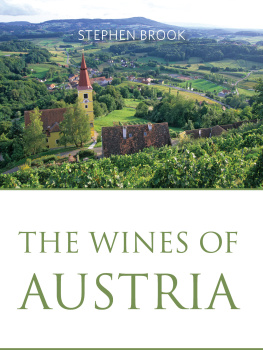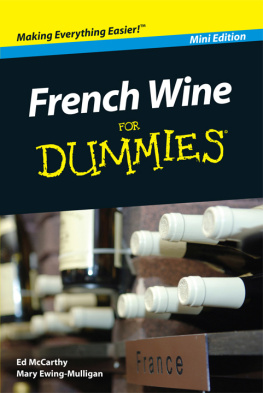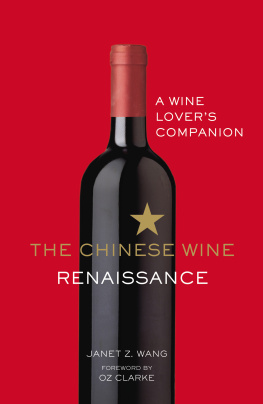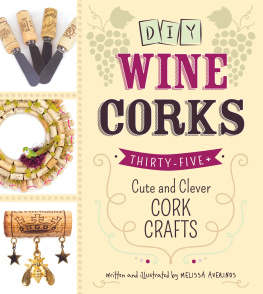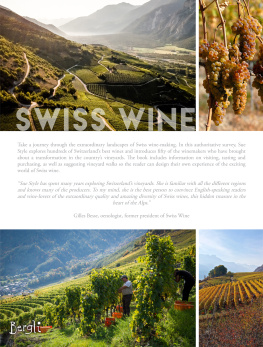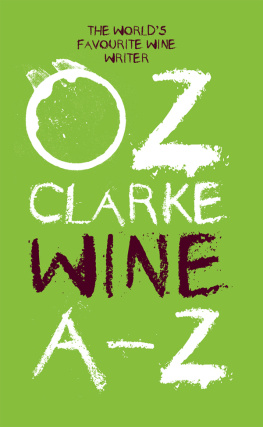THE CLASSIC WINE LIBRARY
Editorial board: Sarah Jane Evans MW, Joshua Greene, Richard Mayson
There is something uniquely satisfying about a good wine book, preferably read with a glass of the said wine in hand. The Classic Wine Library is a series of wine books written by authors who are both knowledgeable and passionate about their subject. Each title in The Classic Wine Library covers a wine region, country or type and together the books are designed to form a comprehensive guide to the world of wine as well as an enjoyable read, appealing to wine professionals, wine lovers, tourists, armchair travellers and wine trade students alike.
The series:
Port and the Douro , Richard Mayson
Cognac: The story of the worlds greatest brandy , Nicholas Faith
Sherry, Julian Jeffs
Madeira: The Islands and their wines, Richard Mayson
The wines of Austria, Stephen Brook
Biodynamic wine, Monty Waldin
Spirits Distilled, Mark Ridgwell
The wines of Faugres, Rosemary George
The story of champagne, Nicholas Faith
THE WINES OF AUSTRIA
STEPHEN BROOK
Copyright Stephen Brook, 2016
The right of Stephen Brook to be identified as the author of this book has been asserted in accordance with the Copyright, Designs and Patents Act 1988.
First published in 2016 by
Infinite Ideas Limited
36 St Giles
Oxford
OX1 3LD
United Kingdom
www.infideas.com
All rights reserved. Except for the quotation of small passages for the purposes of criticism or review, no part of this publication may be reproduced, stored in a retrieval system or transmitted in any form or by any means, electronic, mechanical, photocopying, recording, scanning or otherwise, except under the terms of the Copyright, Designs and Patents Act 1988 or under the terms of a licence issued by the Copyright Licensing Agency Ltd, 90 Tottenham Court Road, London W1T 4LP, UK, without the permission in writing of the publisher. Requests to the publisher should be addressed to the Permissions Department, Infinite Ideas Limited, 36 St Giles, Oxford, OX1 3LD, UK, or faxed to +44 (0) 1865 514777.
A CIP catalogue record for this book is available from the British Library
ISBN 9781910902356
Brand and product names are trademarks or registered trademarks of their respective owners.
Maps OEWM, 1040 Wien
ACKNOWLEDGEMENTS
This book is not the outcome of a few trips to Austria in recent years, but reflects visits spanning almost forty years. In the 1970s and 1980s work of various kinds often brought me to Vienna, where I stayed in the spacious and central flat of my college friend David Bolton and his wife Jean. Weekends would send us off to the local wine regions to sample what was available. To quench our thirst during the week, David used a hand-drawn trolley to bring bottled wines from Viennas Naschmarkt to his cellar. At that time we were nothing more than enthusiastic amateurs, but our excursions showed me the potential of Austrian wines.
Subsequent visits to research articles and books on Sauvignon Blanc and Vienna were often taken with the assistance of Bertold Salomon, then head of Austrian Wine Marketing; and with local pundits such as Walter Kutscher, Willi Balanjuk, and Dorli Muhr of Wine & Partners, all of whom increased my knowledge of Austrian wines. The German wine writer Mario Scheuermann invited me to a rather bizarre Traminer competition in Klch. Austrian Marketing brought me repeatedly to VieVinum in Vienna and to the Austrian Wine Summit, allowing me to taste thousands of wines over the years. Dr Josef Schuller MW of the Wine Academy in Rust organised tastings for me. Alois Kracher introduced me not only to his own glorious sweet wines, but to other Austrian wines he admired and thought I should take note of.
Thirty and even twenty years ago there was scant interest in Austrian wines among the British wine-writing fraternity, but I could always rely on an informed sparring and travelling partner in the form of Giles MacDonogh. His most iniquitous act was to pour me blind a glass of Uhudler, one of Europes most disgusting wines. I had no idea what it was, but Oz Clarke, also present, identified it immediately. Other than Fritz Hallgarten, whose book from 1979 is now a report from a previous age of wine production, MacDonogh was the pioneering writer about Austrian wines, publishing two books on the subject. I learned much from these, and from Philipp Bloms The Wines of Austria .
This new book has been enthusiastically propelled into being by the helpfulness of the Austrian Wine Marketing Board under the dynamic leadership of Willi Klinger, ably supported by Susanne Staggl, Marie-Sophie Lodron, Stephanie Thrr, and Katharina Sailnberger. They have organised numerous research trips and done everything possible to meet my wishes without imposing their own agenda. The Board made no stipulations, no conditions, and has not read let alone corrected a word of my text. I cannot begin to enumerate or thank the many producers who offered me hospitality, time, and information, but the names of Bertold Salomon, Lenz Moser V, Christine Saahs, Willi Brndlmayer, Gerhard Malat, Michael Moosbrugger, Rudi Pichler, the late Alois Kracher, his wife Michaela and his son Gerhard, Heidi Schrck, Kurt Feiler, Axel Stieglmar, and Josef Umathum are just a few of those that spring to mind.
I have learned a great deal from many conversations over the years with prominent Austrian wine writers. Luzia Schrampf has guided me on many tours of Austrian wine regions, and I am indebted to her for her entertaining and informative company. Peter Moser, Peter Schleimer, and Michael Pronay have also provided invaluable guidance, as has Christian Zechmeister of Wein Burgerland. In London Peter Honegger of Newcomer Wines invited me to taste many wines from his enterprising range.
Richard Burton of Infinite Ideas asked me to write a book for his wine series, and ended up with a book about a completely different country. I am extremely grateful for his indulgence.
INTRODUCTION
Earlier writers of books on Austrian wine have had to urge their readers to accept their premise that Austria can make great wines. That is no longer necessary. Austrian wines have for many years been accepted by writers, sommeliers, and even consumers, as world class. The white and nobly sweet wines have attracted the most attention, and rightly so, but there has been great progress in red-wine production and quality over the past decade.
A BRIEF HISTORY OF AUSTRIAN WINE
It took a while for Austrian wines to make their mark. This is largely because until relatively recently they were mostly sold within the country, with some exports to Germany. Yet its history as a wine-producing nation is ancient. It is known that vines were cultivated in eastern Austria in Celtic times, and there were extensive plantings by the Romans, especially in the Danube valley and Styria. Styria is the English name for the area known in German as Steiermark and this name is used extensively in the text that follows, just as Wien is often referred to as Vienna. In AD 92, Emperor Domitian ordered existing vineyards to be pulled out for fear of over-production across the empire; to what extent this decree was observed in remote Austria is not known. At any rate, two centuries later Emperor Aurelius Probus reversed the decree.
After the Romans left in the late fifth century many vineyards were abandoned, and Hungarian invasions in the tenth century made matters worse, especially in Pannonia, the region now straddled by the border between Austria and Hungary. Styria too had many masters before the Habsburgs established their hold over the region in 1282. Charlemagne proved a stabilising influence after he captured what is now Austria in 803 and rules were drawn up for viticulture and wine making. The next major influence was the arrival of mainly Cistercian monks, who came to found monasteries from the eleventh century onwards, notably Stift Heiligenkreuz near Vienna and its outposts. This gave a boost to local viticulture. Wine was needed for sacramental purposes as well as providing a beverage that was safe to drink at a time when that was rarely true of water. Many of the sites planted by monks, most of whom had come from the wine regions of France, Burgundy in particular, are still in production and still under monastic ownership. In the late twelfth century the Viennese were permitted to plant vineyards, which still exist, within the city limits. As the vineyards developed, so did trade, and many wines were exported to northern Europe.
Next page
